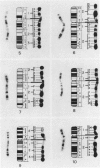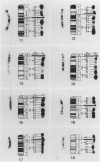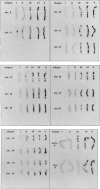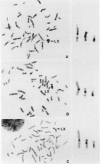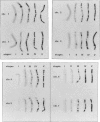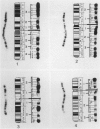Abstract
Combining higher resolution chromosome analysis and bromodeoxyuridine (BrdU) incorporation, our study demonstrates that: (1) Human chromosomes synthesize DNA in a segmental but highly coordinated fashion. Each chromosome replicates according to its innate pattern of chromosome structure (banding). (2) R-positive bands are demonstrated as the initiation sites of DNA synthesis in all human chromosomes, including late-replicating chromosomes such as the LX and Y. (3) Replication is clearly biphasic in the sense that late-replicating elements, such as G-bands, the Yh, C-bands, and the entire LX, initiate replication after it has been completed in the autosomal R-bands (euchromatin) with minimal or no overlap. The chronological priority of R-band replication followed by G-bands is also retained in the facultative heterochromatin or late-replicating X chromosome (LX). Therefore, the inclusion of G-bands as a truly late-replicating chromatin type or G(Q)-heterochromatin is suggested. (4) Lateral asymmetry (LA) in the Y chromosome can be detected after less than half-cycle in 5-bromodeoxyuridine (BrdUrd), and the presence of at least two regions of LA in this chromosome is confirmed. (5) Finally, the replicational map of human chromosomes is presented, and a model of replication chronology is suggested. Based on this model, a system of nomenclature is proposed to place individual mitoses (or chromosomes) within S-phase, according to their pattern of replication banding. Potential applications of this methodology in clinical and theoretical cytogenetics are suggested.
Full text
PDF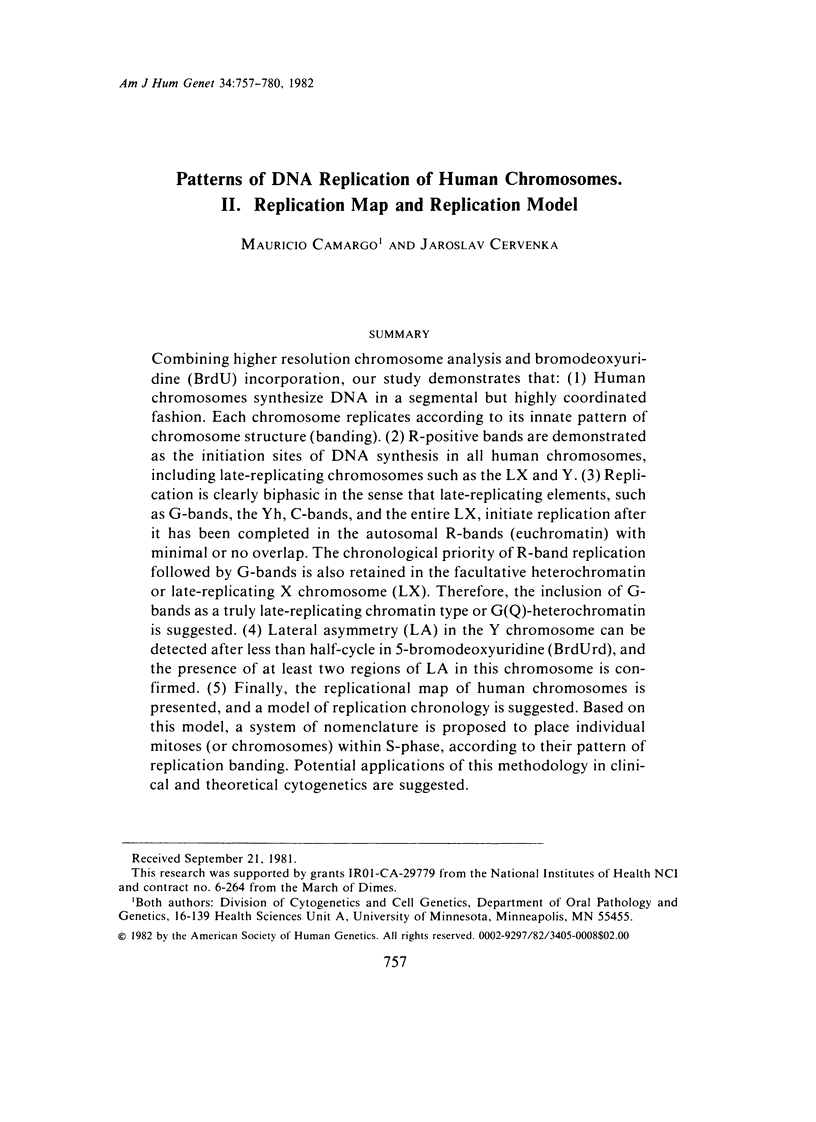
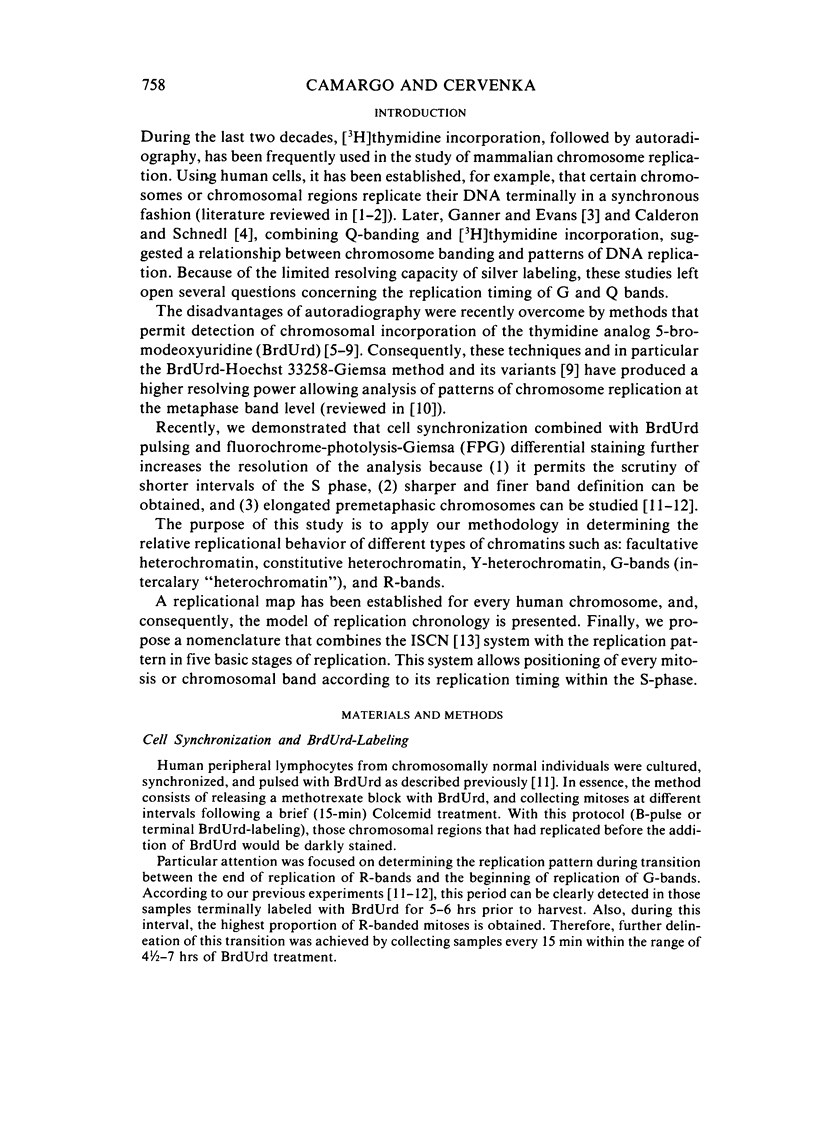
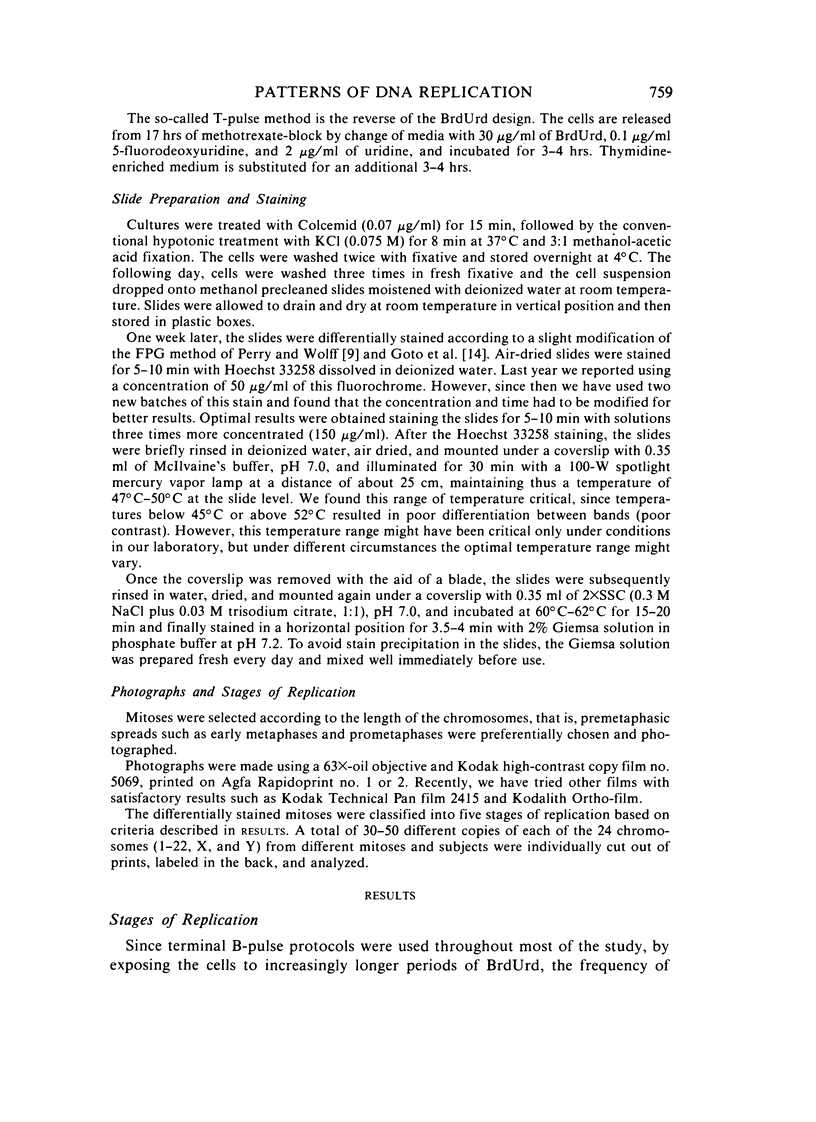
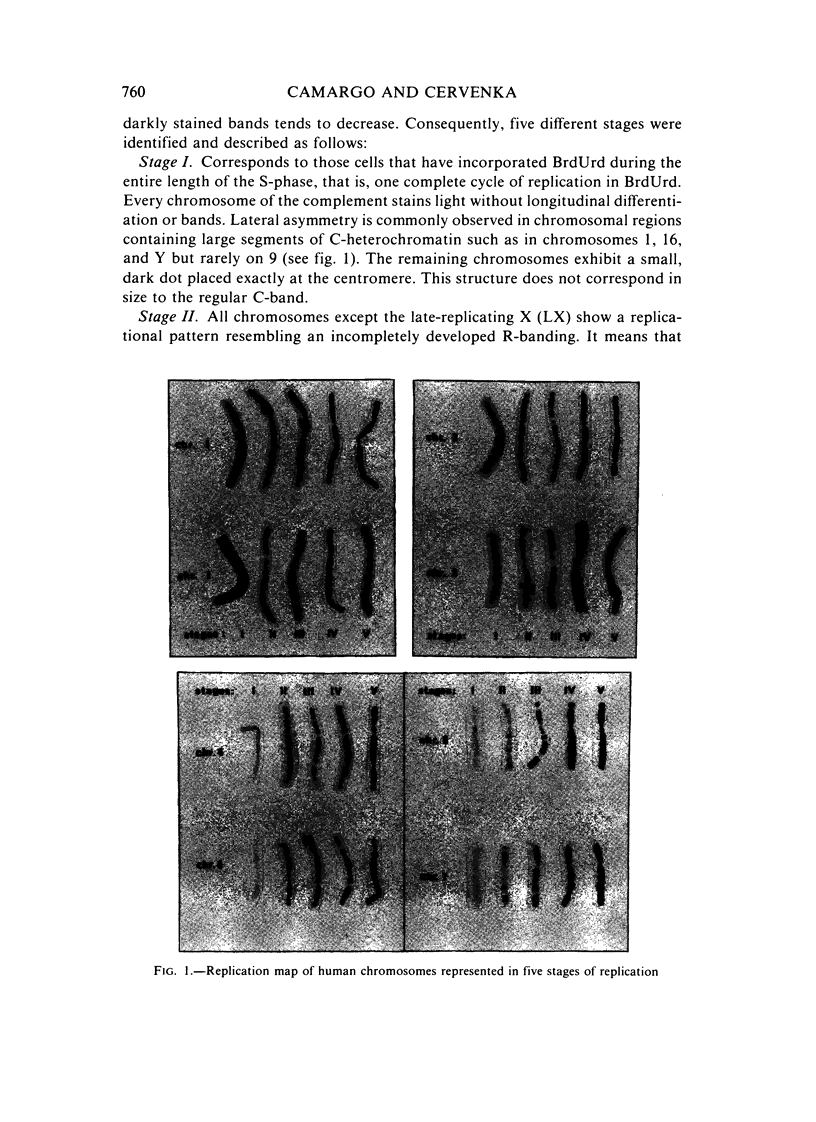
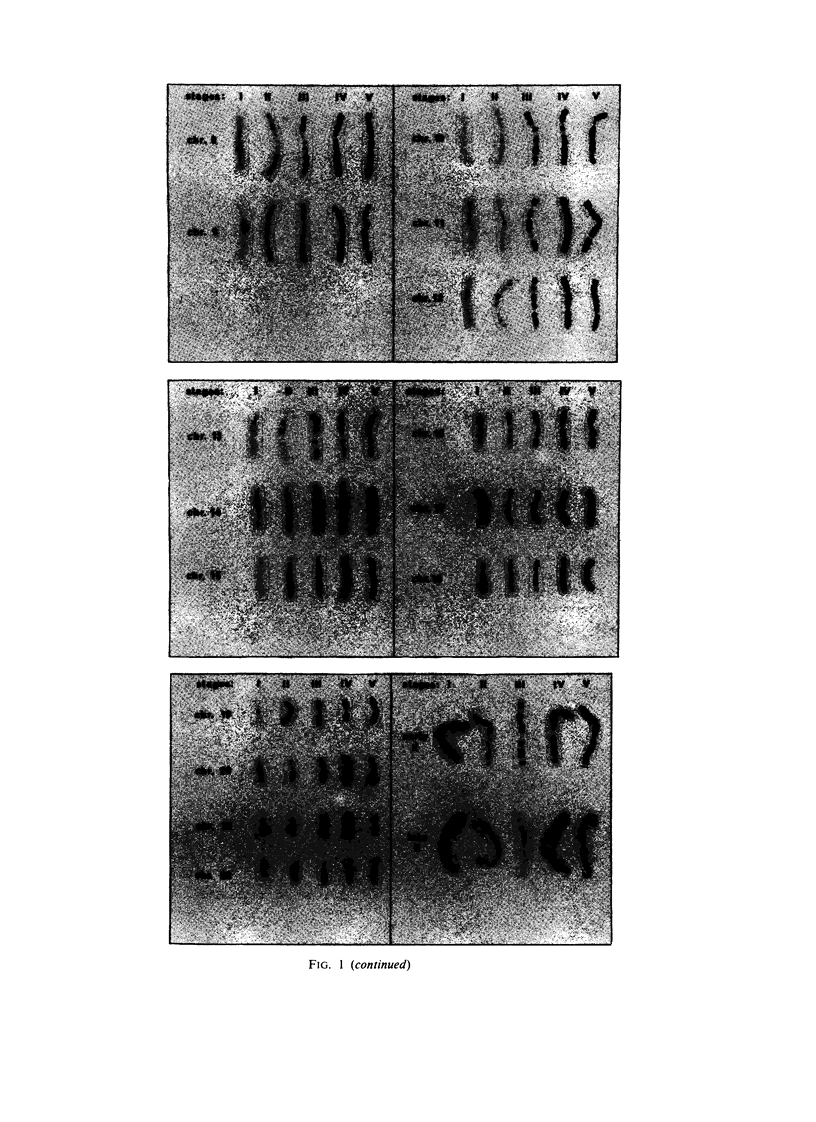
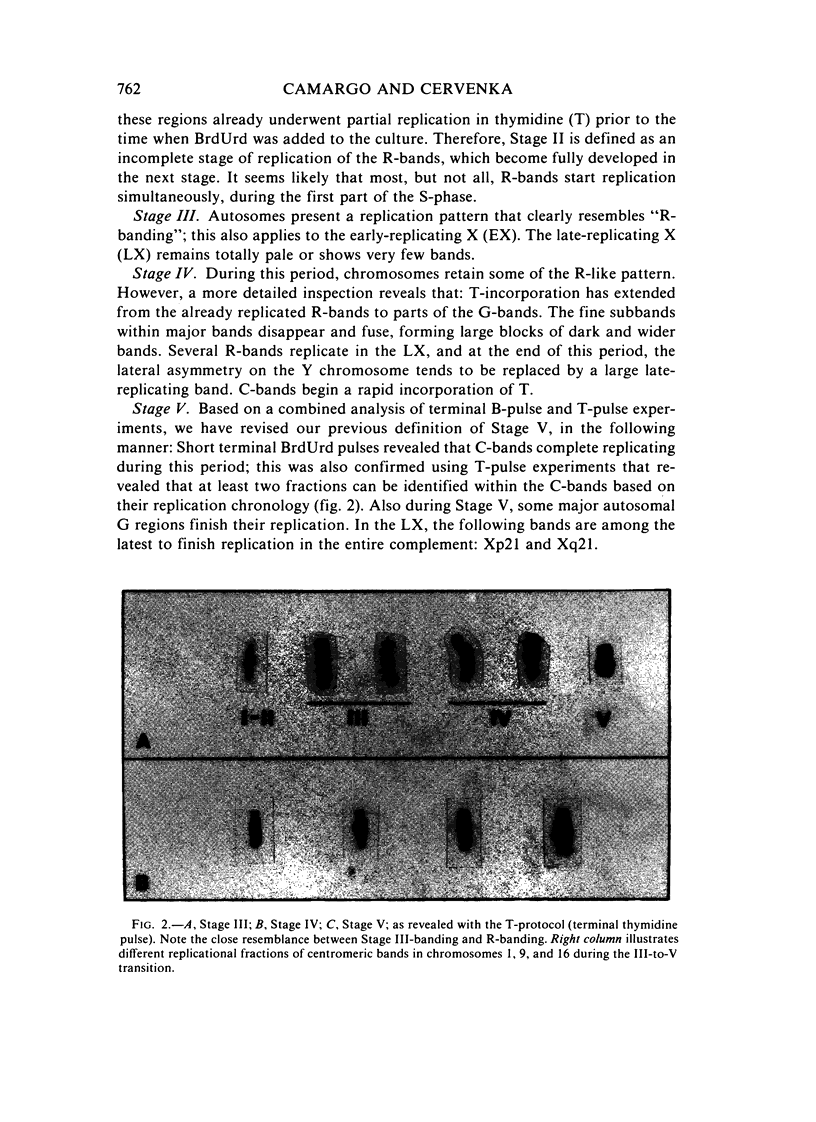
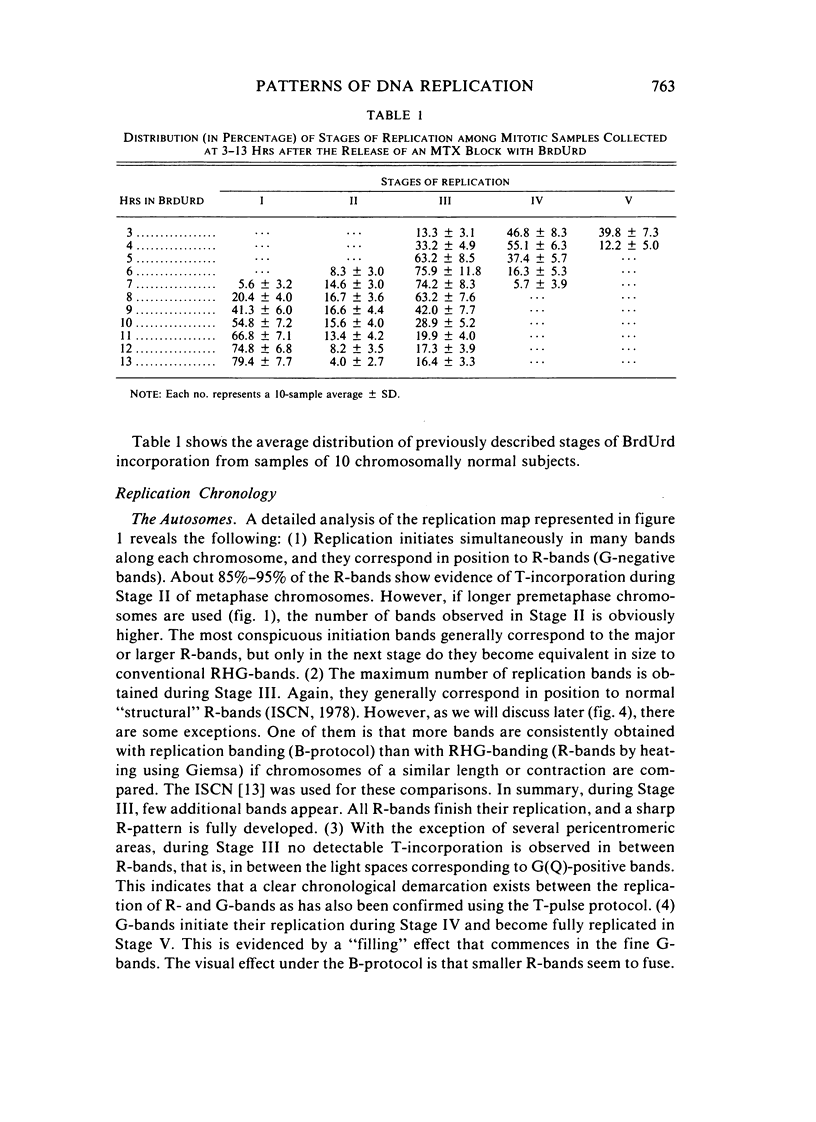
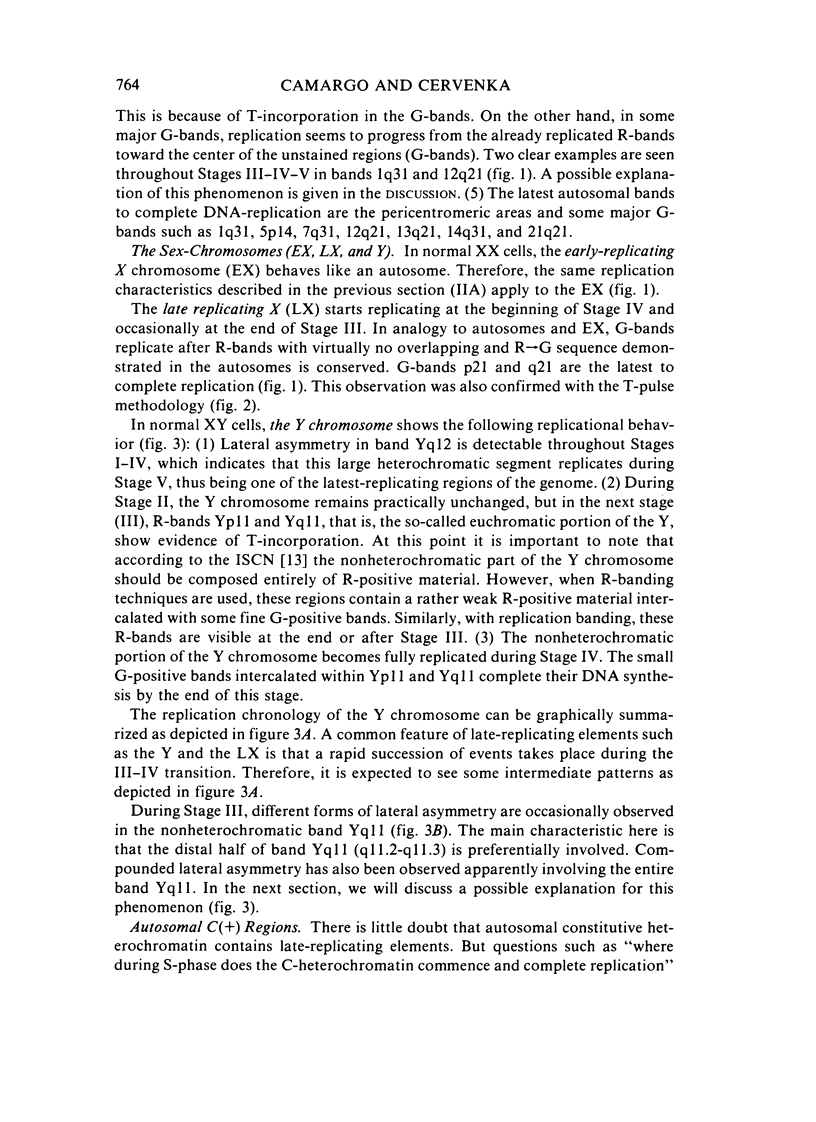
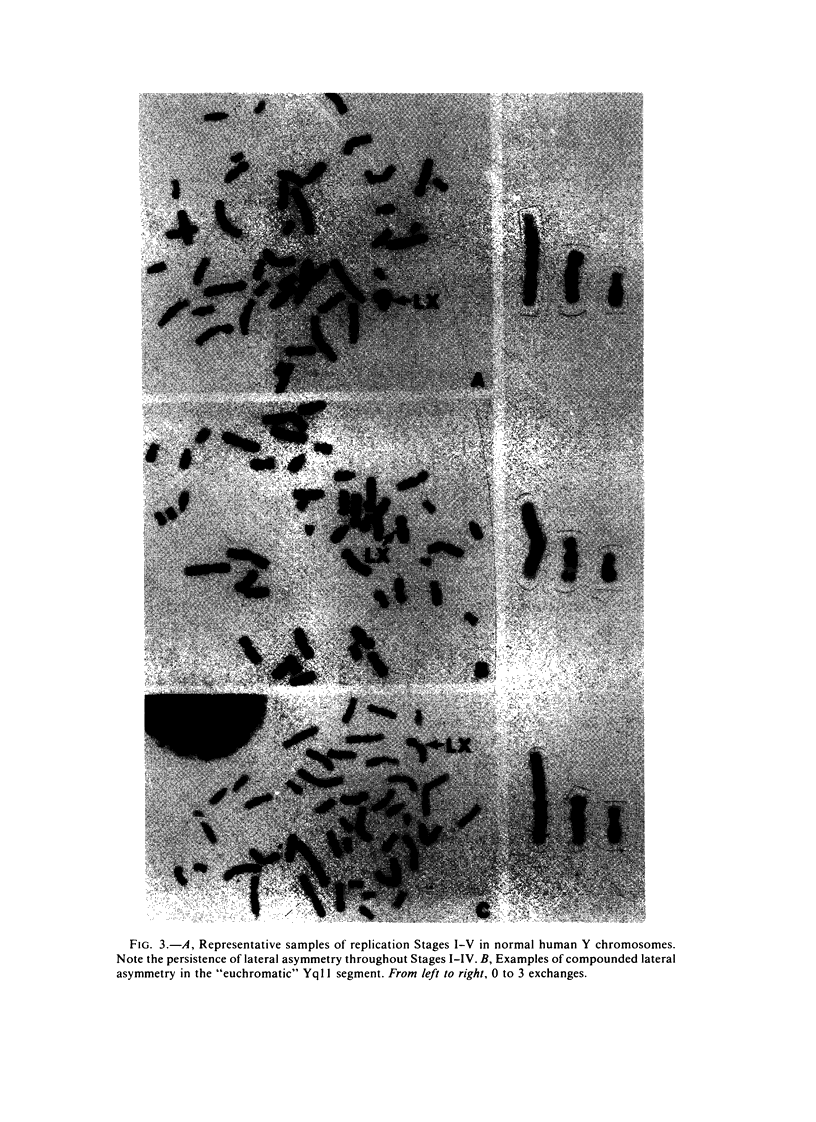
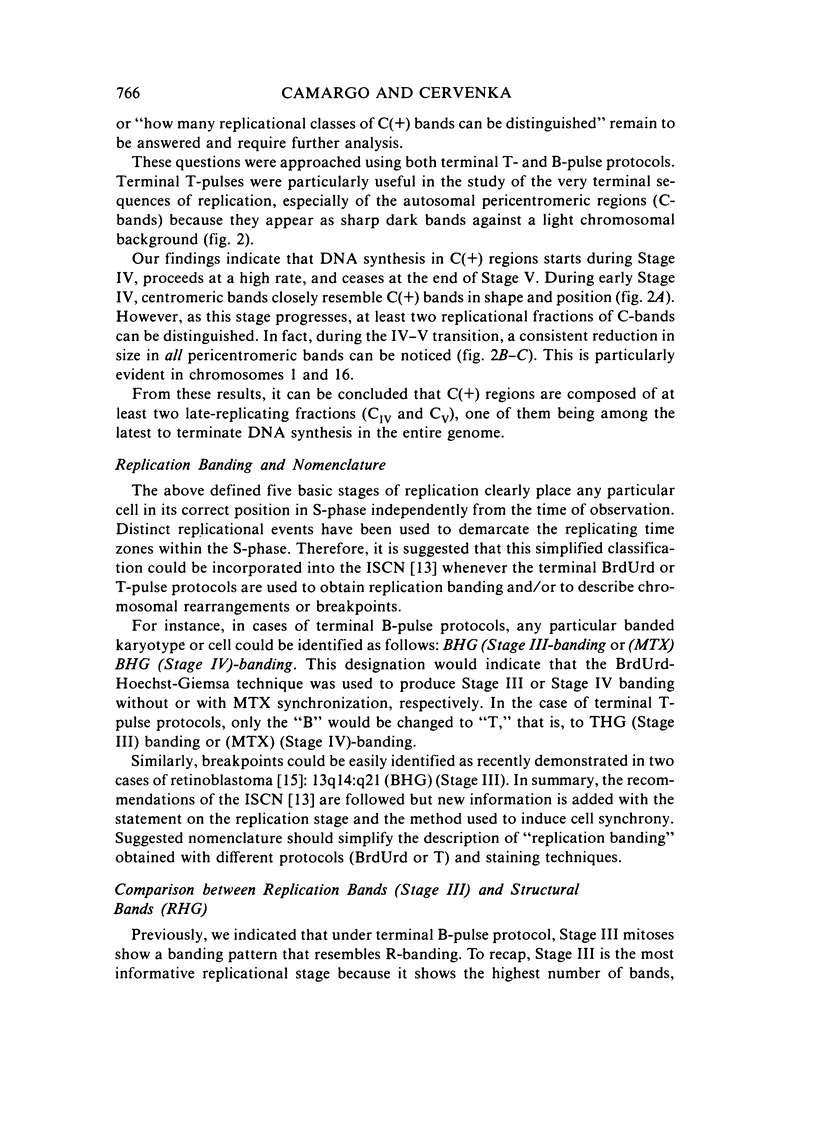
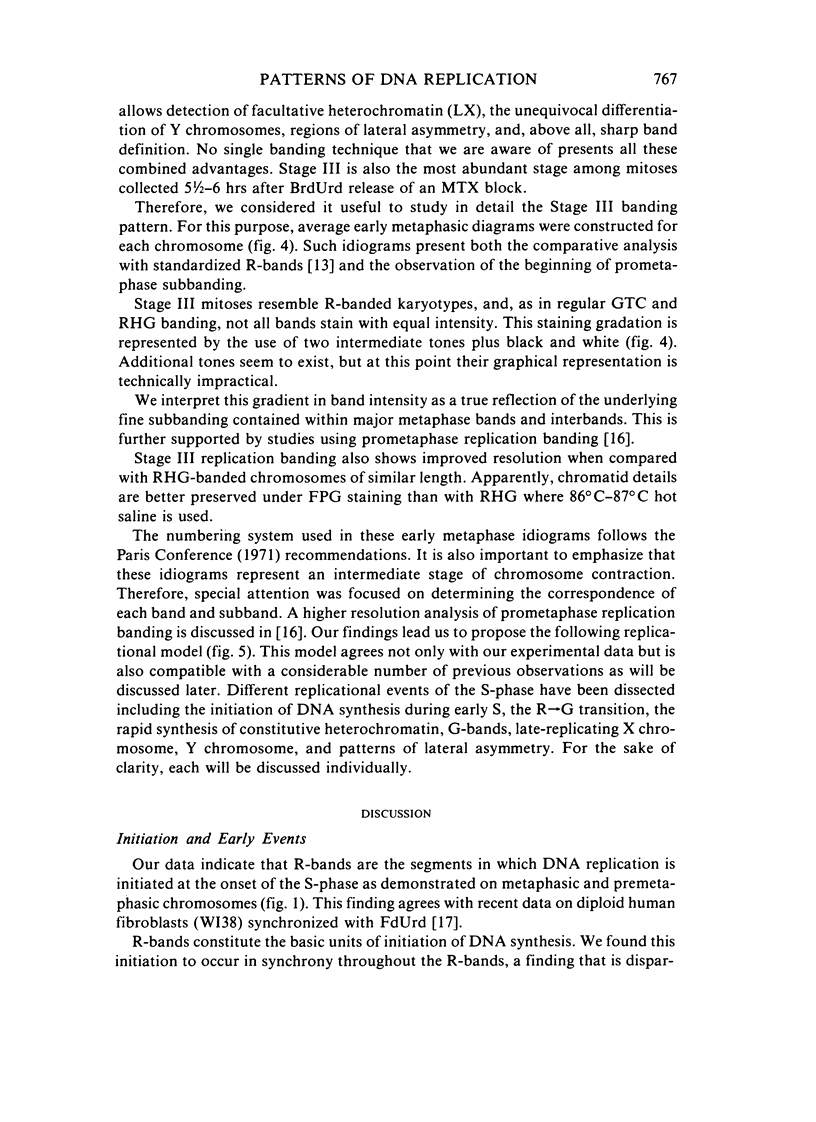
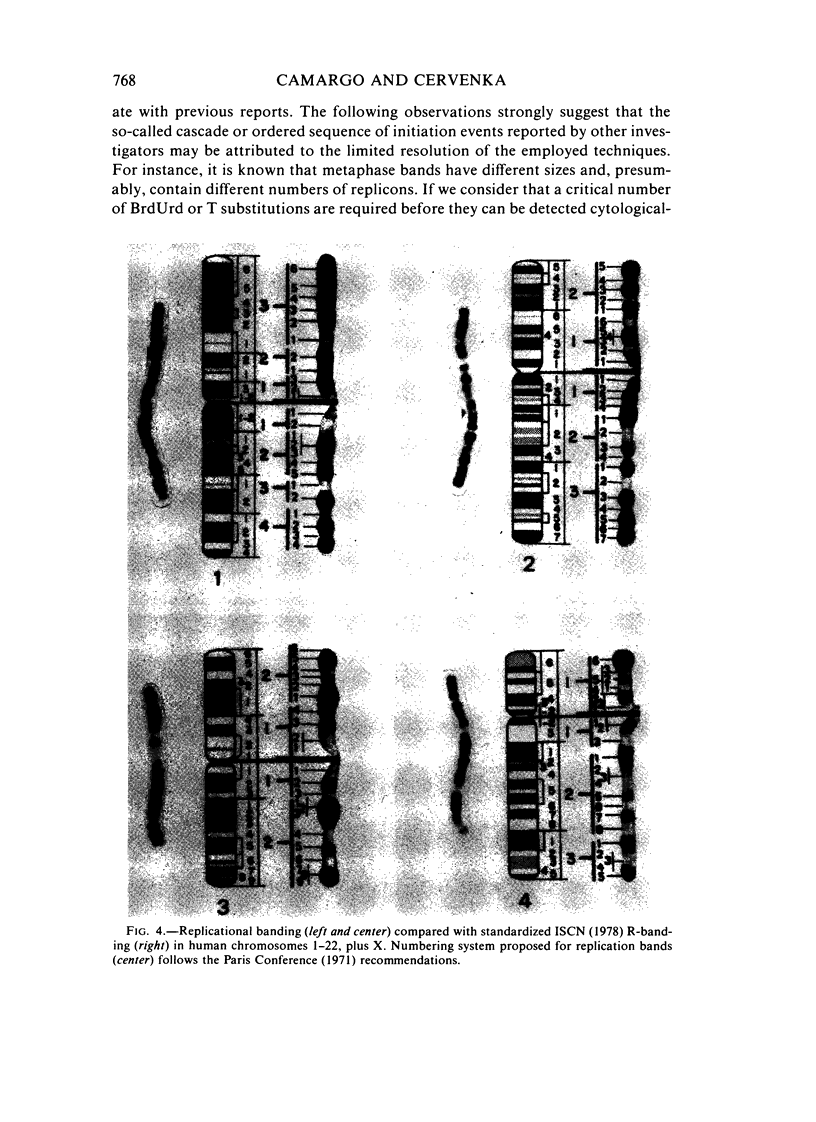
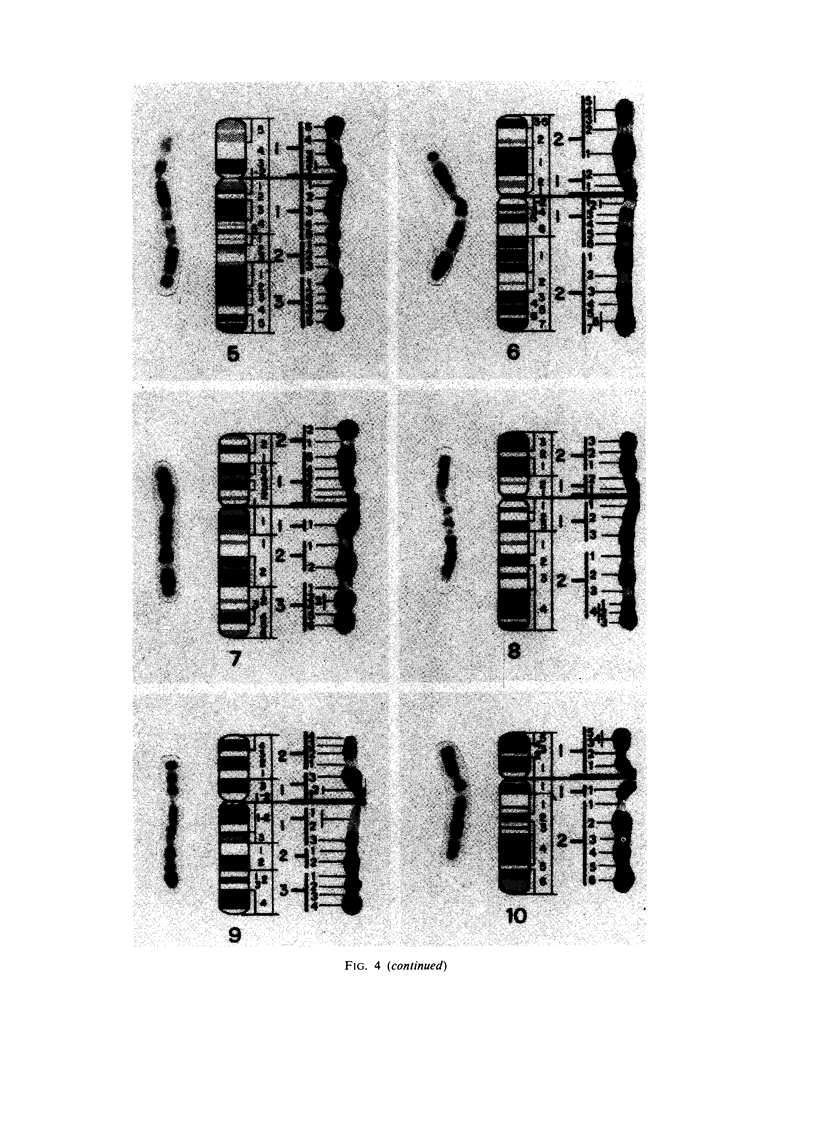
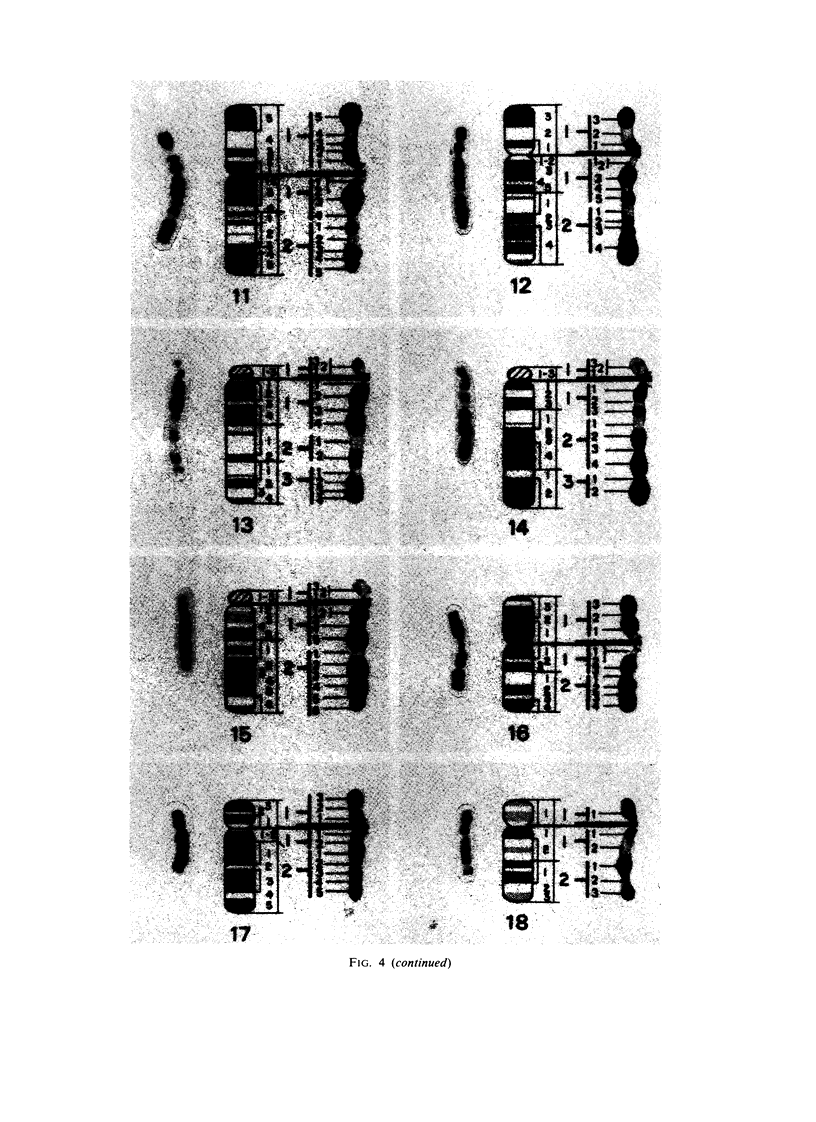
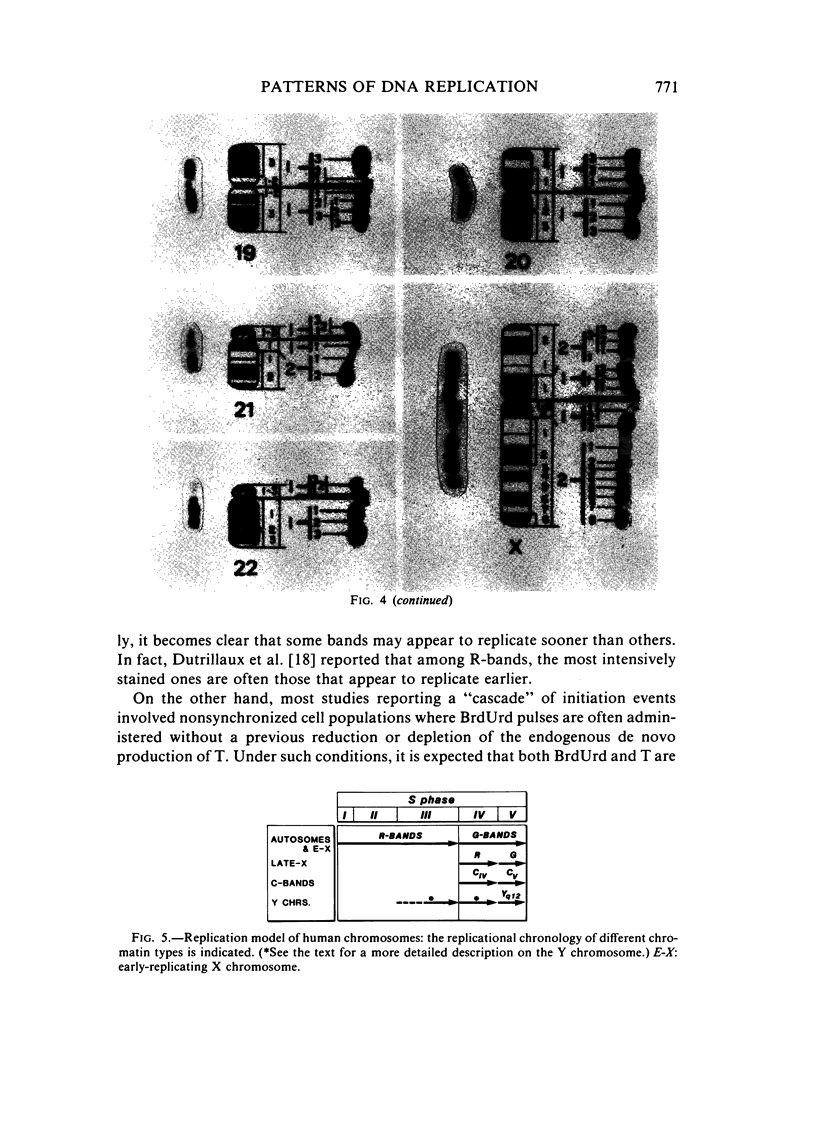

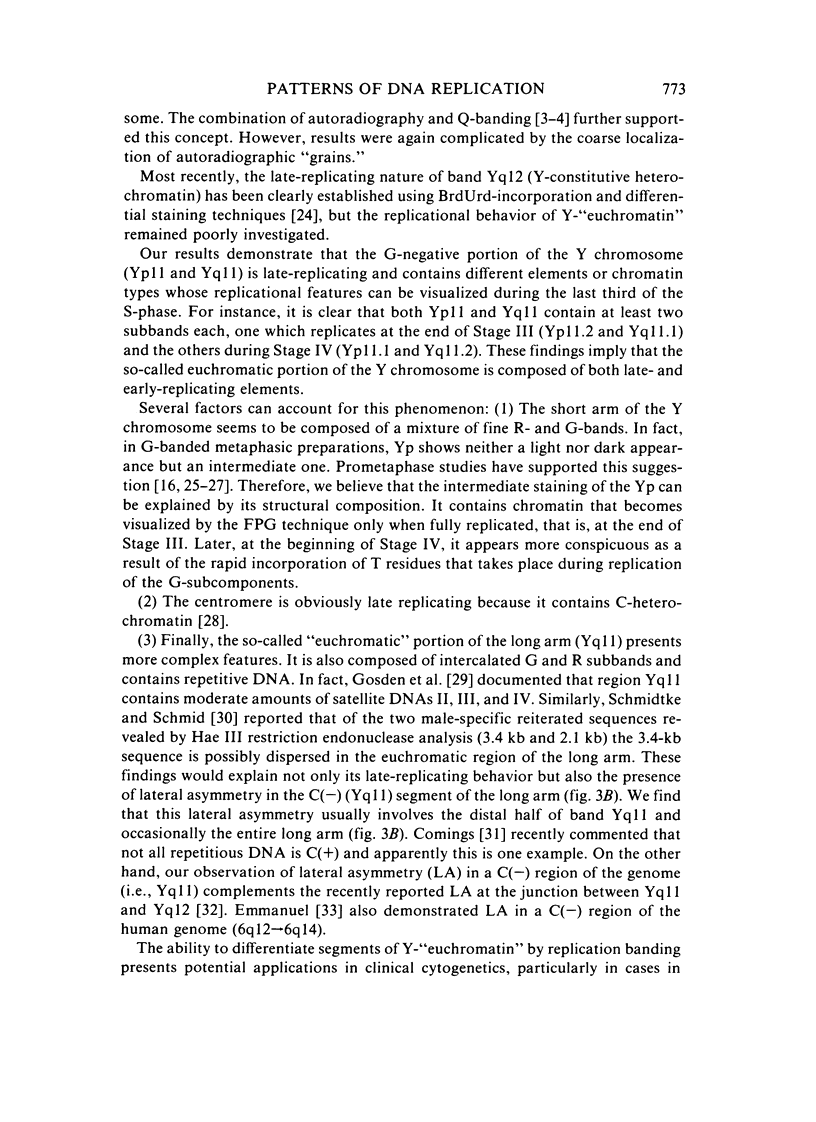
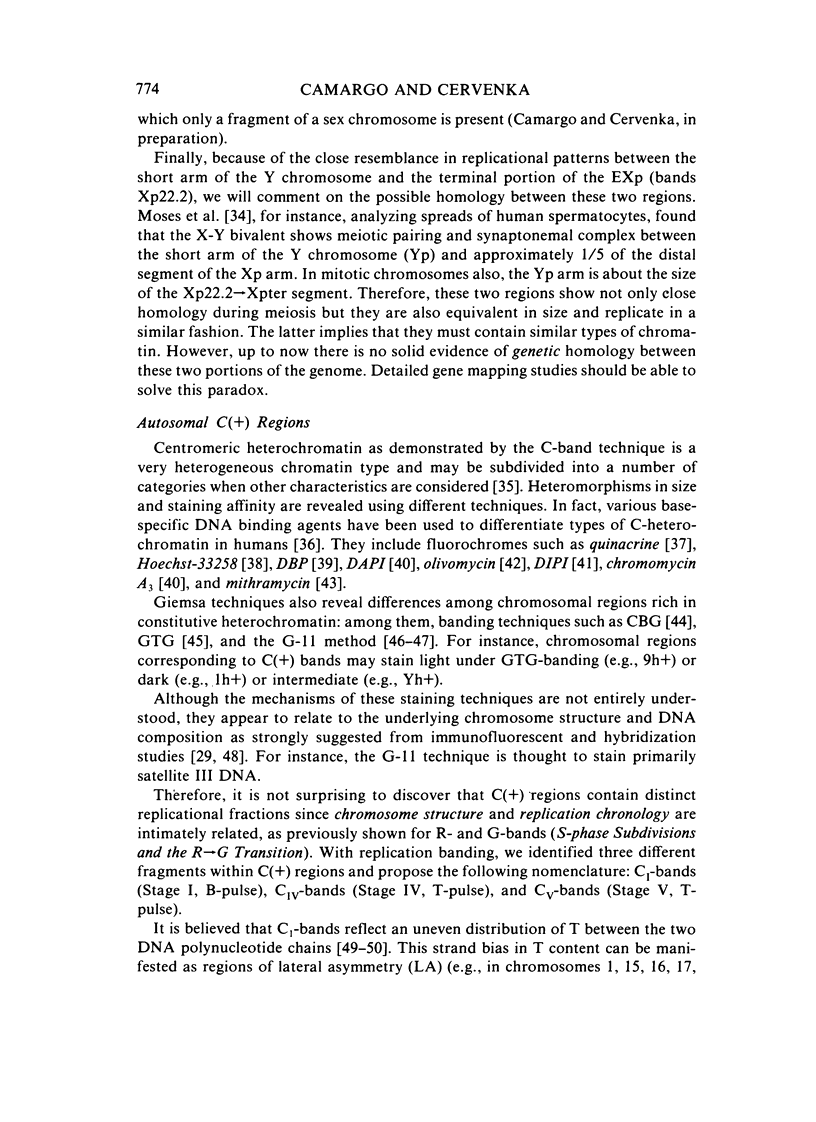
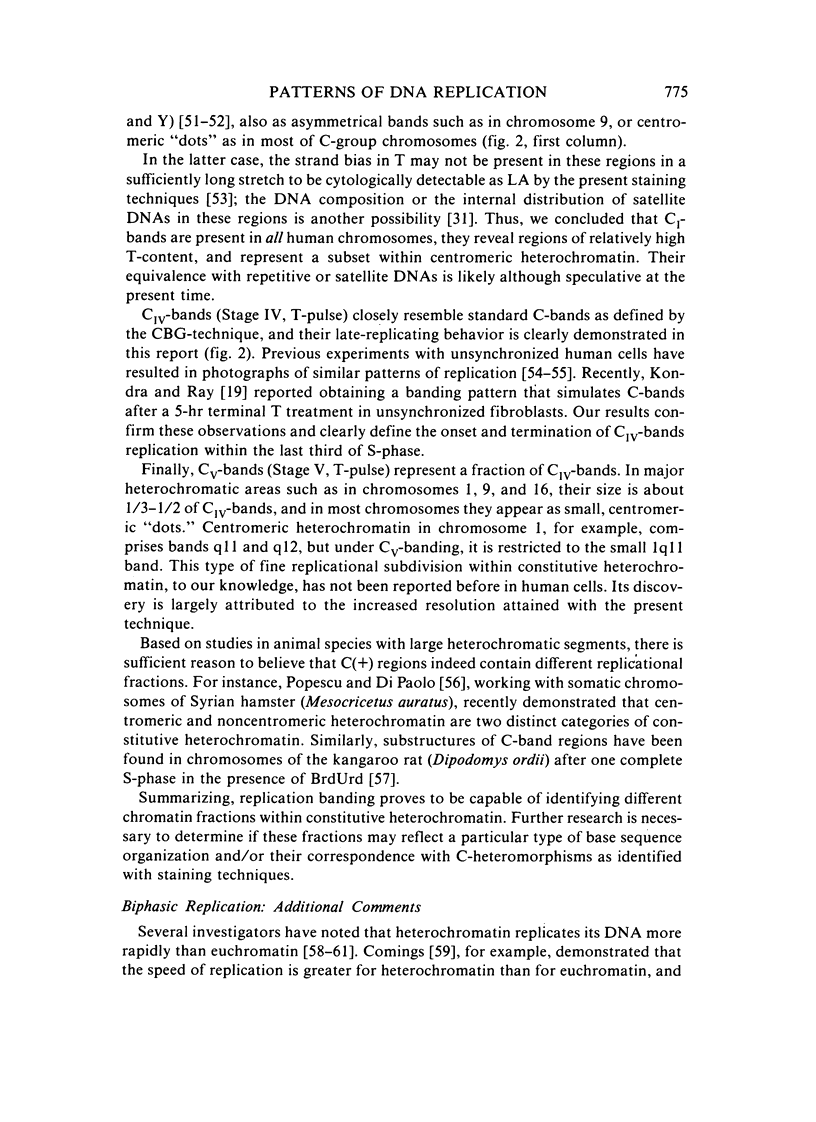
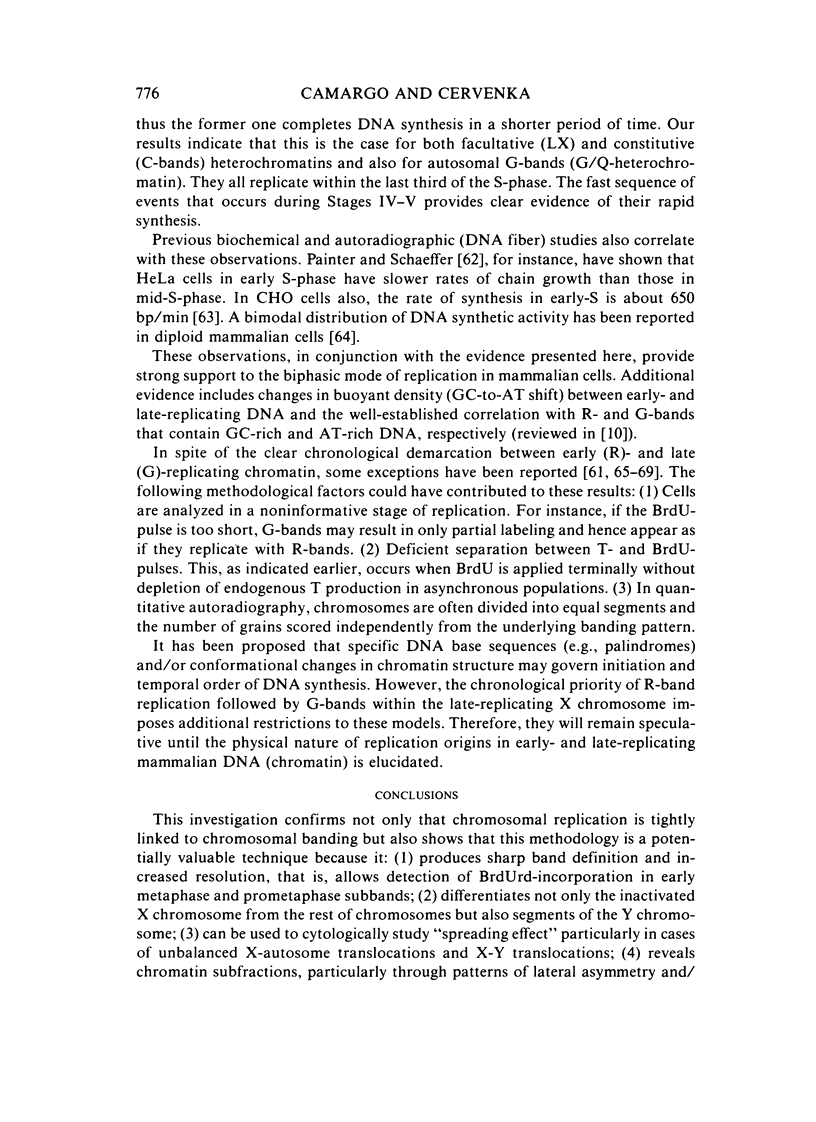

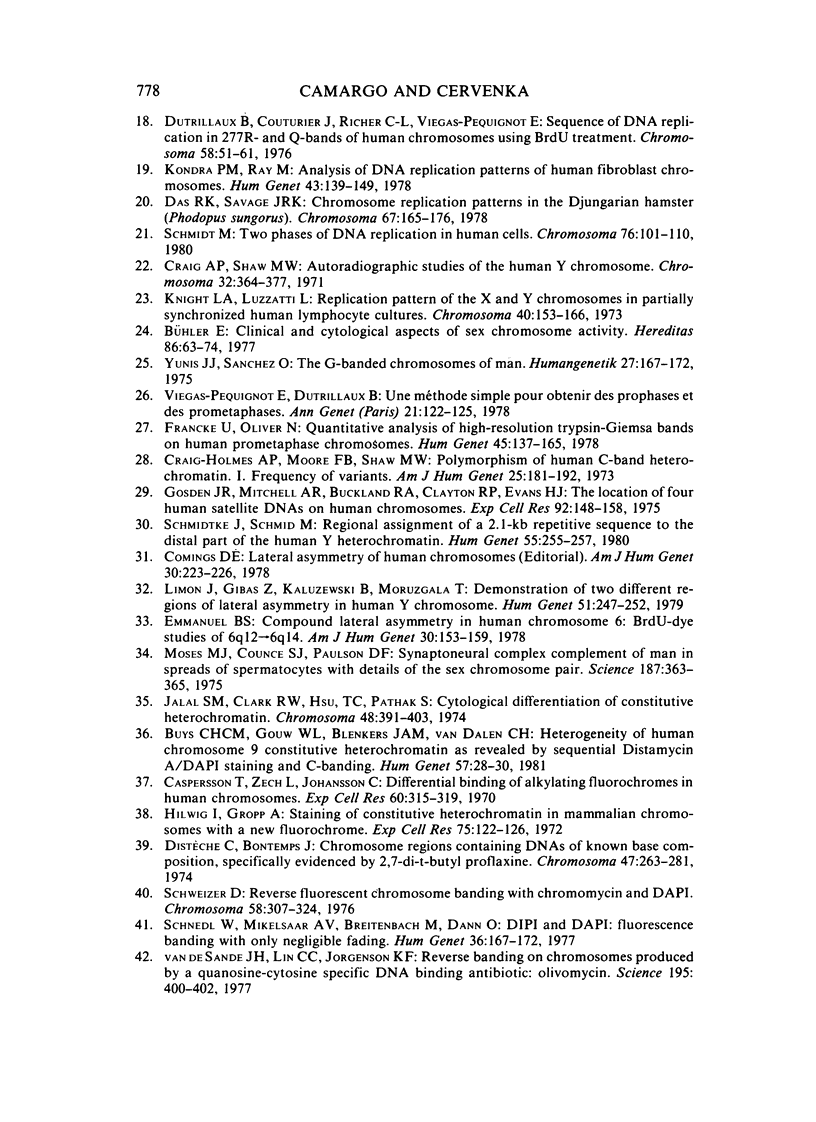
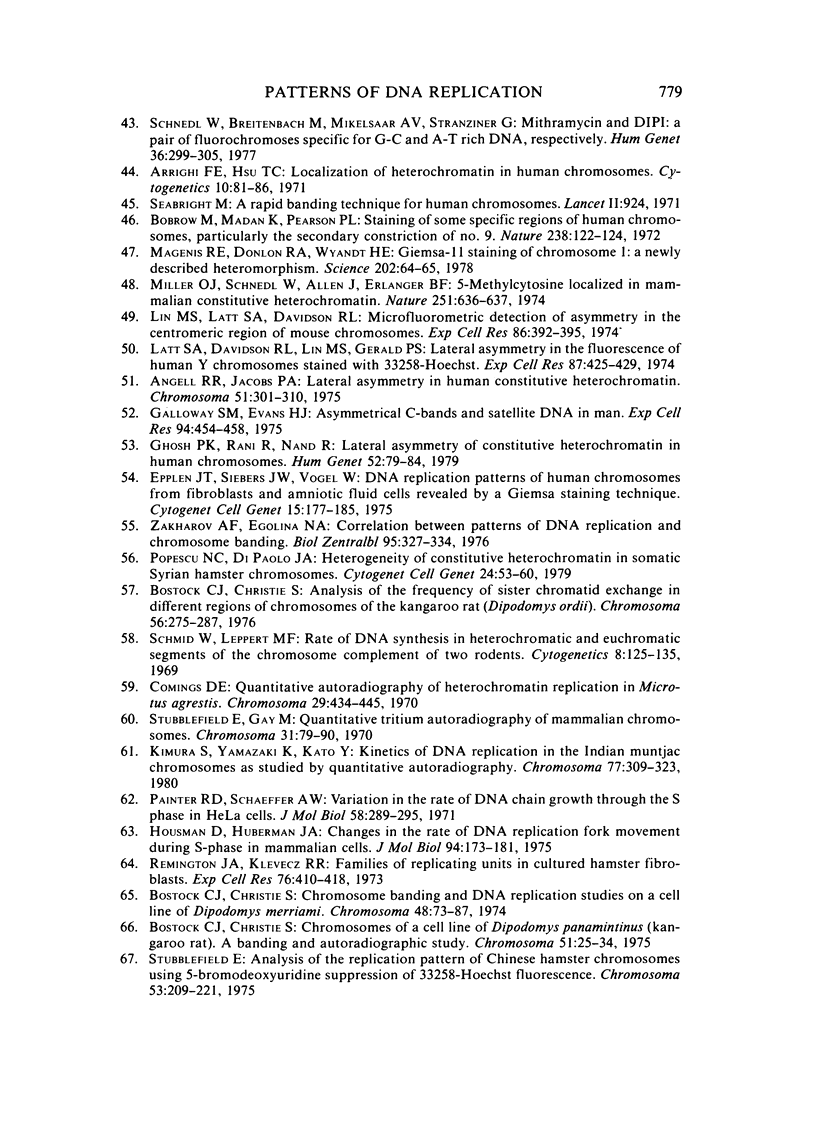

Images in this article
Selected References
These references are in PubMed. This may not be the complete list of references from this article.
- Angell R. R., Jacobs P. A. Lateral asymmetry in human constitutive heterochromatin. Chromosoma. 1975 Aug 11;51(4):301–310. doi: 10.1007/BF00326317. [DOI] [PubMed] [Google Scholar]
- Arrighi F. E., Hsu T. C. Localization of heterochromatin in human chromosomes. Cytogenetics. 1971;10(2):81–86. doi: 10.1159/000130130. [DOI] [PubMed] [Google Scholar]
- Bobrow M., Madan K., Pearson P. L. Staining of some specific regions of human chromosomes, particularly the secondary constriction of No. 9. Nat New Biol. 1972 Jul 26;238(82):122–124. doi: 10.1038/newbio238122a0. [DOI] [PubMed] [Google Scholar]
- Bostock C. J., Christie S. Analysis of the frequency of sister chromatid exchange in different regions of chromosomes of the kangaroo rat (Dipodomys ordii). Chromosoma. 1976 Jul 8;56(3):275–287. doi: 10.1007/BF00293191. [DOI] [PubMed] [Google Scholar]
- Bostock C. J., Christie S. Chromosome banding and DNA replication studies on a cell line of Dipodomys merriami. Chromosoma. 1974;48(1):73–87. doi: 10.1007/BF00284868. [DOI] [PubMed] [Google Scholar]
- Bostock C. J., Christie S. Chromosomes of a cell line of Dipodomys panamintinus (kangaroo rat). A banding and autoradiographic study. Chromosoma. 1975;51(1):25–34. doi: 10.1007/BF00285804. [DOI] [PubMed] [Google Scholar]
- Buys C. H., Gouw W. L., Blenkers J. A., van Dalen C. H. Heterogeneity of human chromosome 9 constitutive heterochromatin as revealed by sequential distamycin A/DAPI staining and C-banding. Hum Genet. 1981;57(1):28–30. doi: 10.1007/BF00271162. [DOI] [PubMed] [Google Scholar]
- Bühler E. Clinical and cytological aspects of sex chromosome activity. Hereditas. 1977;86(1):63–74. doi: 10.1111/j.1601-5223.1977.tb01213.x. [DOI] [PubMed] [Google Scholar]
- Calderon D., Schnedl W. A comparison between quinacrine fluorescence banding and 3H-thymidine incorporation patterns in human chromosomes. Humangenetik. 1973 Mar 23;18(1):63–70. doi: 10.1007/BF00279032. [DOI] [PubMed] [Google Scholar]
- Camargo M., Cervenka J. Pattern of chromosomal replication in synchronized lymphocytes. I. Evaluation and application of methotrexate block. Hum Genet. 1980;54(1):47–53. doi: 10.1007/BF00279048. [DOI] [PubMed] [Google Scholar]
- Camargo M., Johnson M. P., Cervenka J. Delineation of 13q-deletion by replication banding in retinoblastoma. Cytogenet Cell Genet. 1981;31(2):77–83. doi: 10.1159/000131628. [DOI] [PubMed] [Google Scholar]
- Caspersson T., Zech L., Johansson C. Differential binding of alkylating fluorochromes in human chromosomes. Exp Cell Res. 1970 Jun;60(3):315–319. doi: 10.1016/0014-4827(70)90523-9. [DOI] [PubMed] [Google Scholar]
- Comings D. E. Lateral asymmetry of human chromosomes. Am J Hum Genet. 1978 Mar;30(2):223–226. [PMC free article] [PubMed] [Google Scholar]
- Comings D. E. Mechanisms of chromosome banding and implications for chromosome structure. Annu Rev Genet. 1978;12:25–46. doi: 10.1146/annurev.ge.12.120178.000325. [DOI] [PubMed] [Google Scholar]
- Comings D. E. Quantitative autoradiography of heterochromatin replication in Microtus agrestis. Chromosoma. 1970;29(4):434–445. doi: 10.1007/BF00281926. [DOI] [PubMed] [Google Scholar]
- Craig-Holmes A. P., Moore F. B., Shaw M. W. Polymorphism of human C-band heterochromatin. I. Frequency of variants. Am J Hum Genet. 1973 Mar;25(2):181–192. [PMC free article] [PubMed] [Google Scholar]
- Craig A. P., Shaw M. W. Autoradiographic studies of the human Y chromosome. Chromosoma. 1971 Mar 16;32(4):364–377. doi: 10.1007/BF00285250. [DOI] [PubMed] [Google Scholar]
- Das R. K., Savage J. R. Chromosome replication patterns in the Djungarian hamster (Phodopus sungorus). Chromosoma. 1978 Jun 28;67(2):165–176. doi: 10.1007/BF00293174. [DOI] [PubMed] [Google Scholar]
- Distèche C., Bontemps J. Chromosome regions containing DNAs of known base composition, specifically evidenced by 2,7-di-t-butyl proflavine. Comparison with the Q-banding and relation to dye-DNA interactions. Chromosoma. 1974;47(3):263–281. doi: 10.1007/BF00328861. [DOI] [PubMed] [Google Scholar]
- Dutrillaux B., Couturier J., Richer C. L., Viegas-Péquignot E. Sequence of DNA replication in 277 R- and Q-bands of human chromosomes using a BrdU treatment. Chromosoma. 1976 Oct 12;58(1):51–61. doi: 10.1007/BF00293440. [DOI] [PubMed] [Google Scholar]
- Dutrillaux B., Laurent C., Couturier J., Lejeune J. Coloration des chromosomes humains par l'acridine orange après traitement par le 5 bromodéoxyuridine. C R Acad Sci Hebd Seances Acad Sci D. 1973 Jun 13;276(24):3179–3181. [PubMed] [Google Scholar]
- Emanuel B. S. Compound lateral asymmetry in human chromosome 6:BrdU-dye studies of 6q12-->6q14. Am J Hum Genet. 1978 Mar;30(2):153–159. [PMC free article] [PubMed] [Google Scholar]
- Epplen J. T., Siebers J. W., Vogel W. DNA replication patterns of human chromosomes from fibroblasts and amniotic fluid cells revealed by a Giemsa staining technique. Cytogenet Cell Genet. 1975;15(3):177–185. doi: 10.1159/000130516. [DOI] [PubMed] [Google Scholar]
- Francke U., Oliver N. Quantitative analysis of high-resolution trypsin-giemsa bands on human prometaphase chromosomes. Hum Genet. 1978 Dec 18;45(2):137–165. doi: 10.1007/BF00286957. [DOI] [PubMed] [Google Scholar]
- Galloway S. M., Evans H. J. Asymmetrical C-bands and satellite DNA in man. Exp Cell Res. 1975 Sep;94(2):454–459. doi: 10.1016/0014-4827(75)90517-0. [DOI] [PubMed] [Google Scholar]
- Ganner E., Evans H. J. The relationship between patterns of DNA replication and of quinacrine fluorescence in the human chromosome complement. Chromosoma. 1971;35(3):326–341. doi: 10.1007/BF00326282. [DOI] [PubMed] [Google Scholar]
- Ghosh P. K., Rani R., Nand R. Lateral asymmetry of constitutive heterochromatin in human chromosomes. Hum Genet. 1979 Nov 1;52(1):79–84. doi: 10.1007/BF00284600. [DOI] [PubMed] [Google Scholar]
- Gosden J. R., Mitchell A. R., Buckland R. A., Clayton R. P., Evans H. J. The location of four human satellite DNAs on human chromosomes. Exp Cell Res. 1975 Apr;92(1):148–158. doi: 10.1016/0014-4827(75)90648-5. [DOI] [PubMed] [Google Scholar]
- Goto K., Maeda S., Kano Y., Sugiyama T. Factors involved in differential Giemsa-staining of sister chromatids. Chromosoma. 1978 May 16;66(4):351–359. doi: 10.1007/BF00328535. [DOI] [PubMed] [Google Scholar]
- Hilwig I., Gropp A. Staining of constitutive heterochromatin in mammalian chromosomes with a new fluorochrome. Exp Cell Res. 1972 Nov;75(1):122–126. doi: 10.1016/0014-4827(72)90527-7. [DOI] [PubMed] [Google Scholar]
- Housman D., Huberman J. A. Changes in the rate of DNA replication fork movement during S phase in mammalian cells. J Mol Biol. 1975 May 15;94(2):173–181. doi: 10.1016/0022-2836(75)90076-5. [DOI] [PubMed] [Google Scholar]
- Jalal S. M., Clark R. W., Hsu T. C., Pathak Cytological differentiation of constitutive heterochromatin. Chromosoma. 1974;48(4):391–403. doi: 10.1007/BF00290995. [DOI] [PubMed] [Google Scholar]
- Kato H. Spontaneous sister chromatid exchanges detected by a BUdR-labelling method. Nature. 1974 Sep 6;251(5470):70–72. doi: 10.1038/251070a0. [DOI] [PubMed] [Google Scholar]
- Kimura S., Yamazaki K., Kato Y. Kinetics of DNA replication in the Indian muntjac chromosomes as studied by quantitative autoradiography. Chromosoma. 1980;77(3):309–323. doi: 10.1007/BF00286056. [DOI] [PubMed] [Google Scholar]
- Knight L. A., Luzzatti L. Replication pattern of the X and Y chromosomes in partially synchronized human lymphocyte cultures. Chromosoma. 1973;40(2):153–166. doi: 10.1007/BF00321460. [DOI] [PubMed] [Google Scholar]
- Kondra P. M., Ray M. Analysis of DNA replication patterns of human fibroblast chromosomes: the replication map. Hum Genet. 1978 Aug 31;43(2):139–149. doi: 10.1007/BF00293591. [DOI] [PubMed] [Google Scholar]
- Korenberg J. R., Freedlender E. F. Giemsa technique for the detection of sister chromatid exchanges. Chromosoma. 1974;48(4):355–360. doi: 10.1007/BF00290992. [DOI] [PubMed] [Google Scholar]
- Latt S. A., Davidson R. L., Lin M. S., Gerald P. S. Lateral asymmetry in the fluorescence of human Y chromosomes stained with 33 258 Hoechst. Exp Cell Res. 1974 Aug;87(2):425–429. doi: 10.1016/0014-4827(74)90510-2. [DOI] [PubMed] [Google Scholar]
- Latt S. A. Microfluorometric detection of deoxyribonucleic acid replication in human metaphase chromosomes. Proc Natl Acad Sci U S A. 1973 Dec;70(12):3395–3399. doi: 10.1073/pnas.70.12.3395. [DOI] [PMC free article] [PubMed] [Google Scholar]
- Limon J., Gibas Z., Kałuzewski B., Moruzgała T. Demonstration of two different regions of lateral asymmetry in human Y chromosomes. Hum Genet. 1979 Oct 2;51(3):247–252. doi: 10.1007/BF00283390. [DOI] [PubMed] [Google Scholar]
- Lin M. S., Latt S. A., Davidson R. L. Microfluorometric detection of asymmetry in the centromeric region of mouse chromosomes. Exp Cell Res. 1974 Jun;86(2):392–395. doi: 10.1016/0014-4827(74)90727-7. [DOI] [PubMed] [Google Scholar]
- Maegenis R. E., Donlon T. A., Wyandt H. E. Giemsa-11 staining of chromosome 1: a newly described heteromorphism. Science. 1978 Oct 6;202(4363):64–65. doi: 10.1126/science.694520. [DOI] [PubMed] [Google Scholar]
- Miller O. J. Autoradiography in human cytogenetics. Adv Hum Genet. 1970;1:35–130. doi: 10.1007/978-1-4684-0958-1_2. [DOI] [PubMed] [Google Scholar]
- Miller O. J., Schnedl W., Allen J., Erlanger B. F. 5-Methylcytosine localised in mammalian constitutive heterochromatin. Nature. 1974 Oct 18;251(5476):636–637. doi: 10.1038/251636a0. [DOI] [PubMed] [Google Scholar]
- Moses M. J., Counce S. J., Paulson D. F. Synaptonemal complex complement of man in spreads of spermatocytes, with details of the sex chromosome pair. Science. 1975 Jan 31;187(4174):363–365. [PubMed] [Google Scholar]
- Nakagome Y. Initiation of DNA replication in human chromosomes. Exp Cell Res. 1977 May;106(2):457–461. doi: 10.1016/0014-4827(77)90203-8. [DOI] [PubMed] [Google Scholar]
- Painter R. B., Schaefer A. W. Variation in the rate of DNA chain growth through the S phase in HeLa cells. J Mol Biol. 1971 May 28;58(1):289–295. doi: 10.1016/0022-2836(71)90247-6. [DOI] [PubMed] [Google Scholar]
- Perry P., Wolff S. New Giemsa method for the differential staining of sister chromatids. Nature. 1974 Sep 13;251(5471):156–158. doi: 10.1038/251156a0. [DOI] [PubMed] [Google Scholar]
- Popescu N. C., DiPaolo J. A. Heterogeneity of constitutive heterochromatin in somatic Syrian hamster chromosomes. Cytogenet Cell Genet. 1979;24(1):53–60. doi: 10.1159/000131356. [DOI] [PubMed] [Google Scholar]
- Remington J. A., Klevecz R. R. Families of replicating units in cultured hamster fibroblasts. Exp Cell Res. 1973 Feb;76(2):410–418. doi: 10.1016/0014-4827(73)90393-5. [DOI] [PubMed] [Google Scholar]
- Schmid W., Leppert M. F. Rates of DNA synthesis in heterochromatic and euchromatic segments of the chromosome complements of two rodents. Cytogenetics. 1969;8(2):125–135. doi: 10.1159/000130029. [DOI] [PubMed] [Google Scholar]
- Schmidt M. Two phases of DNA replication in human cells. Chromosoma. 1980;76(1):101–110. doi: 10.1007/BF00292230. [DOI] [PubMed] [Google Scholar]
- Schmidtke J., Schmid M. Regional assignment of a 2.1-kb repetitive sequence to the distal part of the human Y heterochromatin. Hum Genet. 1980;55(2):255–257. doi: 10.1007/BF00291774. [DOI] [PubMed] [Google Scholar]
- Schnedl W., Breitenbach M., Stranzinger G. Mithramycin and DIPI: a pair of fluorochromes specific for GC-and AT-rich DNA respectively. Hum Genet. 1977 May 10;36(3):299–305. doi: 10.1007/BF00446280. [DOI] [PubMed] [Google Scholar]
- Schnedl W., Mikelsaar A. V., Breitenbach M., Dann O. DIPI and DAPI: fluorescence banding with only negliglible fading. Hum Genet. 1977 Apr 15;36(2):167–172. doi: 10.1007/BF00273255. [DOI] [PubMed] [Google Scholar]
- Schweizer D. Reverse fluorescent chromosome banding with chromomycin and DAPI. Chromosoma. 1976 Nov 29;58(4):307–324. doi: 10.1007/BF00292840. [DOI] [PubMed] [Google Scholar]
- Stubblefield E. Analysis of the replication pattern of Chinese hamster chromosomes using 5-bromodeoxyuridine suppression of 33258 Hoechst fluorescence. Chromosoma. 1975 Dec 10;53(3):209–221. doi: 10.1007/BF00329172. [DOI] [PubMed] [Google Scholar]
- Stubblefield E., Gay M. Quantitative tritium autoradiography of mammalian chromosomes. II. The kinetics of DNA synthesis in individual chromosomes of Chinese hamster fibroblasts. Chromosoma. 1970;31(1):79–90. doi: 10.1007/BF00321158. [DOI] [PubMed] [Google Scholar]
- Ved Brat S., Verma R. S., Dosik H. Structural organization of chromosomes of the Indian muntjac (Muntiacus muntjak). Cytogenet Cell Genet. 1979;24(4):201–208. doi: 10.1159/000131381. [DOI] [PubMed] [Google Scholar]
- Yunis J. J., Sanchez O. The G-banded prophase chromosomes of man. Humangenetik. 1975;27(3):167–172. doi: 10.1007/BF00278343. [DOI] [PubMed] [Google Scholar]
- van de Sande J. H., Lin C. C., Jorgenson K. F. Reverse banding on chromosomes produced by a guanosine-cytosine specific DNA binding antibiotic: olivomycin. Science. 1977 Jan 28;195(4276):400–402. doi: 10.1126/science.63994. [DOI] [PubMed] [Google Scholar]



